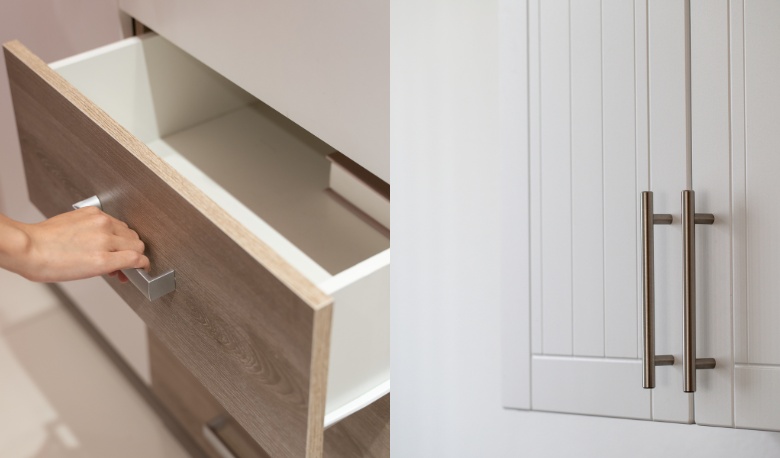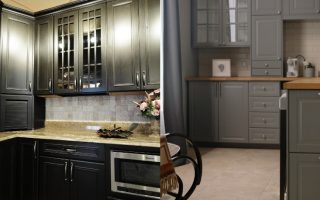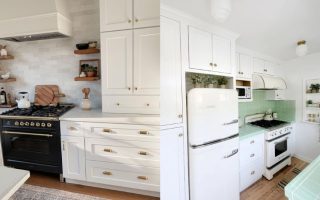Updating your kitchen or bathroom cabinets with new hardware is an easy and affordable way to achieve a fresh, stylish look. However, choosing the perfect cabinet pulls involves more than just aesthetics—ensuring a proper fit is crucial for comfortable use and avoiding unnecessary damage to your cabinetry. This guide will walk you through the simple process of measuring cabinet pulls, whether you’re replacing existing ones or installing them for the first time.
Understanding Cabinet Pull Measurements
Before you begin, let’s clarify the key measurements for finding the right cabinet pulls:
- Center-to-Center Distance: This is the most critical measurement. It indicates the distance between the centers of the screw holes on your existing or desired cabinet pulls.
- Overall Length: This refers to the length of the pull from end to end. While less important for fitting, it plays a role in the overall appearance.
- Projection: This is the distance the pull extends outward from the cabinet face. Important for ensuring fingers can comfortably grip the handle.
Tools You’ll Need
Gather these simple tools to streamline the process:
- Screwdriver (if replacing existing pulls)
- Ruler or measuring tape
- Pencil or marker (optional)
How to Measure Cabinet Pulls for Replacement
Replacing your old cabinet pulls is a fantastic way to update the look of your cabinetry without a major investment. To ensure your new pulls fit perfectly, follow these simple steps:
1. Remove the existing pulls
Begin by carefully unscrewing the existing pulls from your cabinets or drawers. Use the appropriate screwdriver to prevent damage to the screws or your cabinetry. Take this opportunity to clean any accumulated dirt or grime around the old hardware.
2. Measure the center-to-center distance
The center-to-center distance is the most critical measurement when replacing cabinet pulls. Using a ruler or measuring tape, determine the distance between the centers of the screw holes left by the old pulls. Note this measurement carefully, as it will ensure your new pulls align perfectly.
3. Measure the overall length (optional)
While the overall length is mainly an aesthetic consideration, measuring your old pulls can be helpful if you want to maintain a similar look and feel. Determine the length of the pull from one end to the other.
4. Measure the projection (optional)
The projection of a cabinet pull is how far it extends from the cabinet or drawer surface. While not always critical, it’s good to measure this, especially if you have limited space behind the pulls or prefer a specific clearance for your fingers.
How to Measure Cabinet Pulls for a New Installation
Installing cabinet pulls on brand new cabinetry gives you the ultimate flexibility to customize their placement and create a look that’s uniquely yours. Here’s how to ensure perfect positioning:
1. Decide on the desired pull style and size
Before you start marking and drilling, take a step back and consider your overall design preferences. Do you favor sleek, modern hardware, or something more ornate and traditional? Also, keep the size of your cabinets and drawers in mind – larger surfaces generally work well with longer pulls for a balanced look. Visualize how different styles and sizes of pulls complement the rest of your kitchen or bathroom.
2. Determine pull placement
Where you place your pulls impacts both functionality and visual appeal. Many hardware manufacturers provide templates to help you visualize different placements. You can also use masking tape to temporarily position pulls and get a feel for what looks best. Consider both ergonomics (comfortable reach) and aesthetics (overall balance).
3. Mark the screw hole locations
Once you’re completely satisfied with your chosen pull style and the placement, it’s time to make your marks. Use a pencil or marker for easy adjustments if needed. A ruler or level will ensure your marks are precise and prevent uneven installation.
4. Drill the holes
The final step! Carefully drill the holes you marked for the pull screws. Choose a drill bit size that matches the diameter of your hardware’s screws. Work steadily and with controlled pressure to avoid chipping or damaging the cabinet surface.
Tips for Choosing the Right Cabinet Pull Size
Selecting the right size cabinet pulls is a blend of visual appeal and practical comfort. Consider these tips to ensure your new hardware looks beautiful and functions flawlessly:
- Scale: Think Proportionally The size of your cabinet pulls should generally be proportionate to the cabinets or drawers they’ll adorn. Large cabinets and drawers naturally pair well with longer pulls for a balanced look and feel. Smaller cabinets and drawers often benefit from shorter pulls to avoid a visually overwhelming appearance. Keep in mind that overly small pulls on large drawers can look out of place.
- Comfort: Ergonomics Matter Imagine comfortably using your cabinets and drawers on a daily basis. Select pulls that provide enough surface area for a good grip and consider the projection (how far it extends from the surface). You’ll want ample space for your fingers to comfortably open your cabinets and drawers day in and day out.
- Style: Maintain Design Harmony Your cabinet pulls shouldn’t exist in isolation – they should contribute to the cohesive design of your kitchen or bathroom. Consider the overall style you wish to achieve – modern, traditional, minimalist, rustic, etc. Keep the style and finish of your pulls consistent with other fixtures and design elements in the room for a polished and well-designed look.
Remember, there are some general guidelines for choosing cabinet pull sizes, but don’t be afraid to experiment a bit to find what works perfectly for your space and personal preferences!
Common Cabinet Pull Sizes
While custom sizes exist, most cabinet pulls fall into these standard center-to-center measurements:
- 3 inches (76 mm)
- 3.5 inches (89 mm)
- 3.75 inches (96 mm)
- 4 inches (102 mm)
- 5 inches (127 mm)
- 6.25 inches (160 mm)
- 8 inches (203 mm)
- 12 inches (305 mm) or longer
Additional Considerations
- Single Hole Knobs: If you’re working with knobs instead of pulls, you only need to consider the diameter of the knob.
- Drilling New Holes: If your replacement pulls have a different center-to-center distance, you may need to fill the old holes with wood putty or filler, sand, and refinish them before drilling new holes.
- Appliance Pulls: Larger appliances like fridges or dishwashers often require long, sturdy pulls.
Conclusion
Measuring and installing cabinet pulls is a straightforward DIY project that can significantly enhance the look and functionality of your home. With the right measurements and a touch of careful planning, you’ll transform your cabinetry in no time. Remember to experiment with placement, consider the size and style of your cabinets, and choose a finish that complements your overall aesthetic.
FAQs
To address some common user questions, include the following FAQ section:
Q. Do I always need to match the existing center-to-center distance when replacing pulls?
A. Ideally, yes. Matching the existing distance prevents the need to drill new holes and patch the old ones. However, if you’re absolutely in love with a pull that has a slightly different measurement, you can fill and patch the old holes for a clean installation.
Q. What’s a comfortable projection for cabinet pulls?
A. Ideally, there should be about 1 to 1.5 inches of space between your fingers and the cabinet when gripping a pull. Test this out when selecting the hardware.
Q. Can I mix different styles of cabinet pulls in my kitchen?
A. It’s generally recommended to keep hardware styles consistent within a space. However, there’s room for creativity, as long as the finishes and overall design aesthetic remain harmonious.
A Final Word of Encouragement
Don’t be afraid to express a little personality with your cabinet hardware choices! With endless styles available, from sleek and modern to ornate and traditional, finding the perfect pulls to express your individuality is part of the fun.




